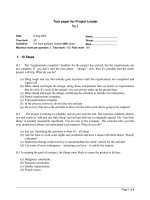- Trang chủ >>
- Luật >>
- Luật dân sự
cloze test 5
Bạn đang xem bản rút gọn của tài liệu. Xem và tải ngay bản đầy đủ của tài liệu tại đây (82.31 KB, 2 trang )
<span class='text_page_counter'>(1)</span>Cloze (10 points / 0.5 point each) Directions: There are 20 blanks in the following passage. For each blank there are four choices marked (A), (B), (C) and (D). You should choose the ONE that best fits into the passage. Then write the corresponding letter on the Answer Sheet. Test Paper A A language is a signaling system which operates with symbolic vocal sounds, and which is used by a group of people for the purpose of communication. Let’s look at this ___1___ in more detail because it is language, more than anything else, ___2___ distinguishes man from the rest of the ___3___ world. Other animals, it is true, communicate with one another by ___4___ of cries: for example, many birds utter ___5___ calls at the approach of danger; monkeys utter ___6___ cries, such as expressions of anger, fear and pleasure. ___7___ these various means of communication differ in important ways ___8___ human language. For instance, animals’ cries do not ___9___ thoughts and feelings clearly. This means, basically, that they lack structure. They lack the kind of structure that ___10___ us to divide a human utterance into ___11___. We can change an utterance by ___12___ one word in it with ___13___: a good illustration of this is a soldier who can say, e.g., “tanks approaching from the north”, ___14___ who can change one word and say “aircraft approaching from the north” or “tanks approaching from the west”; but a bird has a single alarm cry, ___15___ means “danger!” This is why the number of ___16___ that an animal can make is very limited: the great tit is a case ___17___ point; it has about twenty different calls, ___18___ in human language the number of possible utterances is ___19___. It also explains why animal cries are very ___20___ in meaning. 1. 2. 3. 4. 5. 6. 7. 8. 9. 10. 11. 12. 13. 14. 15. 16. 17. 18.. (A) classification (A) that (A) native (A) ways (A) mating (A) identical (A) But (A) about (A) infer (A) encourages (A) speeches (A) replacing (A) ours (A) so (A) this (A) signs (A) in (A) whereas. (B) definition (B) it (B) human (B) means (B) exciting (B) similar (B) Therefore (B) with (B) explain (B) enables (B) sounds (B) spelling (B) theirs (B) and (B) that (B) gestures (B) at (B) since. (C) function (C) as (C) physical (C) methods (C) warning (C) different (C) Afterwards (C) from (C) interpret (C) enforces (C) words (C) pronouncing (C) another (C) but (C) which (C) signals (C) of (C) anyhow. (D) perception (D) what (D) animal (D) approaches (D) boring (D) unfamiliar (D) Furthermore (D) in (D) express (D) ensures (D) voices (D) saying (D) others (D) or (D) it (D) marks (D) for (D) somehow.
<span class='text_page_counter'>(2)</span> 19. (A) boundless (B) changeable (C) limitless 20. (A) ordinary (B) alike (C) common 1-5 BADBC 6-10 CACDB 11-15 CACBC 16-20 CAACD. (D) ceaseless (D) general.
<span class='text_page_counter'>(3)</span>









